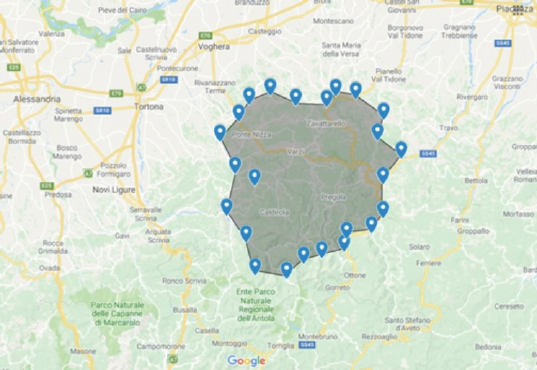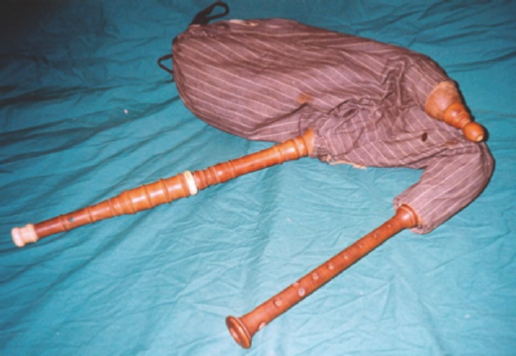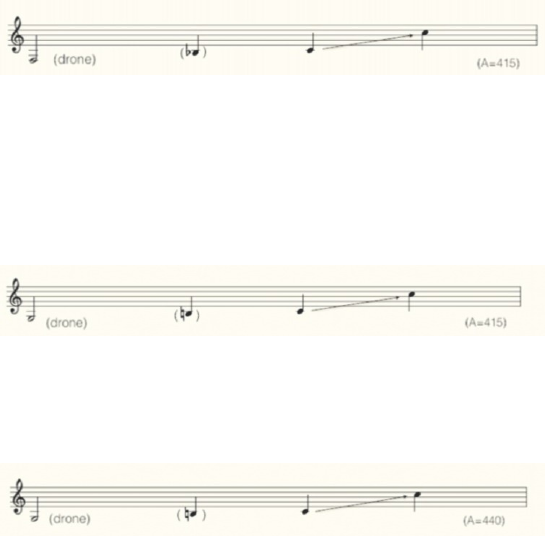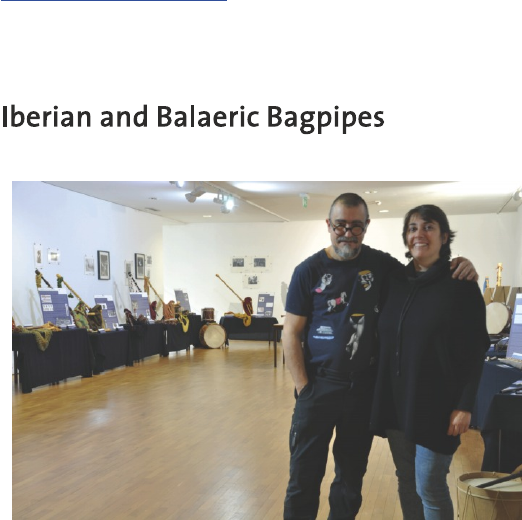The Bagpipe Society
The Müsa: Original Instruments and a Hypothesis on Scales and Tunings
In Chanter n. 30, vols. 3 and 4 (2016) I talked of the müsa in the Edinburgh museum, concentrating on that specific instrument with technical drawings, but many pages were dedicated to a general description and background of the müsa, no need to repeat it here. I will just give a short note about it as the aim of this article is to enlist all the surviving instruments and to propose an hypothesis on its tuning as since the ‘70s, when musicological research started, one of the most debated topics was the scale of the chanter and which note the drone played, a question still debated today.
The müsa is a bagpipe with a conical chanter and one drone, typical of a small mountain area divided between the provinces of Pavia, Genoa, Alessandria and Piacenza and known locally as the “region of the Four Provinces” where you can listen to a huge repertoire of traditional music, dances and songs, played on the region iconic instrument, the piffero, a loud shawn about 40cm long and pitched in G. The piffero is accompanied by the accordion today but it was with the müsa that formed an unbreakable bond until a hundred years ago.
The map, overleaf, shows a line connecting all the towns where traditional music is still played on a regular basis; of course it is also played on many occasions outside of this area but I considered only the places that offer music all the time.
The peculiarity of this pairing is that the two instruments aren’t in the same key: the piffero is in G while the müsa uses a higher scale. This means that they can’t just play the same melody like other shawm/bagpipe couples (e.g. in Brittany), but a kind of polyphony. Unfortunately, we don’t have any recording of the old players, and that’s why we are still questioning which way the müsa played in the past. The most logical choice seems to be using parallel thirds on a G drone but this method doesn’t always work, first of all because the traditional tunes aren’t always in G: many are in D, C, and A minor.

Moreover the structure of traditional dances (Alessandrina, Monferrina, Piana, Giga…) is usually in two or four parts, with second and fourth part repeated: A-BB or A-BB-C-DD, and lots of tunes change key between parts. A very short prelude is played before any tune, to let the dancers know that the dance is starting, and in the same way a “cadenza” is played at the end. Both prelude and postlude are always in G, no matter which key is the rest of the tune. Also there is a short break between each part, where the müsa plays a few measures to let the piffero player breath and the dancers prepare to the next figure; this part is today leaved to the accordion and by evidence the role of the müsa in accompaniment was equivalent.
Surviving Original Instruments
Over the last 15 years I have measured many old instruments in both museums and private collections, but it is the Museo Guatelli in Ozzano Taro that has the most remarkable collection. All the original müse(i) are in Italy except the one in Edinburgh. Below is a list of all the instruments I know of, 21 in total. Most are just fragments and we have only two complete ones preserving all the parts: chanter, drone, bag, stocks, reeds.

A rare complete müsa from Nicolò Bacigalupo “u Grixiu” (=the grey) from Cicagna, an important maker in the beginning of the 20th century.
- Complete müsa in a private collection near Torino
- Complete müsa in the National Museum of Scotland, Edinburgh, catalogue number 1947-117 (ii)
We have only three more which preserve at least chanter and drone:
3. Chanter, drone and blowpipe of the “Pragaja-Creidöra” müsa, private collection, Milano
4. Chanter and drone from “Langin”, private collection, Montoggio 5. Chanter, drone, blowpipe in the Museo Guatelli, Ozzano Taro, cat. number A13
(100-103)
The same museum holds many other instrument parts: 6-8. three chanters – catalogued A80, A81, A82 9-10. two complete drones – A83, A84 11. and a drone end section – A85
Except from the Guatelli A13 müsa that shows signs of use, the other instruments in this museum were stored in the maker’s workshop and it seems they were never played. Another important collection, the Lascito Cuneo in Calvari, has:
12-13. Two chanters 14-16. Three drones 17. The first section of another drone all with no catalogue number.(iii)
Finally we have four more pieces in private collections:
- The ebony chanter played by Carlo Buscaglia*“Pillo”*, in Negruzzo (PV) 19. Another chanter from an unknown maker, in Bobbio (PC) 20-21. Two drone end sections, in Cegni (PV)
The older instruments in the list (number 2, 4, 5 in particular) are pitched lower than the 20th century ones by almost a semitone; at the turn of the century the piffero started to play with the accordion, encouraged by famous players like Piansereju, BrigiottuandJacmòn.(iv) Thanks to this major change they were able to introduce to the repertoire modern couple dances like polca, valzer, mazurca; but new instruments tuned at A=440 were required and they were made by Nicolò BacigalupoU Grixiu in his workshop in Cicagna near Genova. This maker, active between 1900 and 1930 made also several müse, even if the instrument was falling out of use, so we have many by him and they are shorter in length: under 300mm while the older ones are between 315 and 318mm. Number 1, 3, 6-8, 18 in the list are surely made byu Grixiu. The drones 9, 10, 11 were found in his workshop but we cannot say for sure he made them.
The maker of instruments number 2, 4, 5, 12-17 and 19-21 is still anonymous.
A hypothesis on the scale and tuning

The first references of the müsa are in documents of the 16th century but we don’t know if it had been a solo instrument, in the first moment of its long history, or was created on purpose to join the piffero. However, to play solo melodies it should have a drone that matches the chanter scale. Today the drone plays G but has holes in the bottom part, normally open when played; if we close all the holes we do not reach a note much lower than G. We can obtain a F sharp - completely useless - or maximum a F natural.
Let’s suppose that the drone originally had no holes and played F. Then it would be possible to play tunes in F, having the tonic in the middle of the chanter, and going up and down a fifth in range (up to C6 and down to B4). The drone holes could be a later addition, made on purpose to raise the note from F to G when playing with the piffero.
But to play in F major it would be better to have a B flat as chanter lower note, and in some early exemplars (like Guatelli A13 and Edinburgh) we see an extra hole drilled just under the bottom note, in attempt to raise its pitch.
Using the same argument of the holes on the drone, I suppose that the chanter’s bottom note (in parenthesis in the diagrams) was originally a B flat instead of B natural; B natural being another adaptation to match the piffero.
The range written above could have been the original one. Did the müsa sound like that in the past? Maybe we’ll never know…but the extra holes on chanter and drone are a clue to support this theory. Note that the pitch of the older instruments was much lower, more or less one semitone, around A=415 instead of A=440.
The next step was the instrument in its classic form, suitable to play with the piffero: the drone plays G and the chanter a C major scale, with bottom note B natural. The pitch is still around A=415.
It now comes to the time when the accordion takes a central role in the music of the Quattro Province, and suddenly a new generation of pifferi starts to be made in modern pitch at A=440. The müsa had to follow this step, raising up by almost half a tone; this is the müsa that is currently used today since its revival in the 80’s, that can even play in a trio setting, with piffero and accordion.

But, if we give a closer look to the müse made by Nicolò Bacigalupo in the first years of the 20th century, there is another mystery to solve: these instruments have an extremely large low C hole (the chanter fundamental note, closed with RH little finger). In fact, it is not possible to play C natural opening this hole: it will be too sharp. The first one who faced the problem was musicologist Vittorio Messori in his 2012 book “piffero e musa”.ᵛ
Messori has a new approach to the problem of the drone holes; his speculation is that they were not just a vestige inherited from older instruments, but were in use. When playing dance repertoire, the drone played G, but opening the holes it was possible to raise the note up to A. Thanks to the C# in the chanter scale, an A major harmony was obtained: not very useful for the dance tunes, but suitable to vocal music, a rich repertoire of ritual or narrative songs called “stranot”.
These tunes were not played in the same setting of dance nights but on different occasions, then the müsa player had time enough to change the drone tuning up to A by opening all the holes (the holes were normally closed with beeswax plugs, that are still to be found on many historical instruments). When they went back to play for the dancers, the drone was set in G again, and the C natural on the chanter could be played by half covering of the little finger hole: an uncomfortable technique for sure but possible with some practice. The consumption in some chanters, precisely around this hole, may suggest that this skill was used.
The latest type is the most represented among original instruments,including one complete müsa (n. 1) and at least six more chanters. But with the passing of the last players this tradition ended, losing a musical heritage that lasted for centuries. Although this layout, with the chanter keynote raised up a semitone, seems quite weird, it is possible to achieve interesting musical results. I think a revival of the müsa in all his historical variants would be really intriguing.
Of course, the ideas exposed in this chapter are just hypotheses, they are supported by some elements but still don’t allow any confirmation. It is however curious to note, if we look at the four diagrams with the instrument’s range, a constant raise in the pitch through time, both in the drone and in the chanter.

(i) müse = plural of müsa
(ii) see Daniele Bicego “The Edinburgh Müsa” inChanter – Journal of the Bagpipe Society, vol. 30 no. 3
& 4, Autumn-Winter 2016
(iii) Photos and diagrams of the instruments in Guatelli and Cuneo collections can bu found at http://www.baghet.it/musa4province.html
(iv)Lorenzo BavaPiansereju (1826-1894), Paolo PelleBrigiottu(1861-1903), Giacomo Sala*Jacmòn (1873- 1962)
(v) Vittorio Messori, Piffero e Musa, cd booklet, Associazione Musa, Cosola
- Data Processing Notice (GDPR)
-
@BagpipeSociety on X (formally known as Twitter)
-
TheBagpipeSociety on Instagram
-
 BagpipeSociety on Facebook
BagpipeSociety on Facebook
Something wrong or missing from this page? Let us know!
